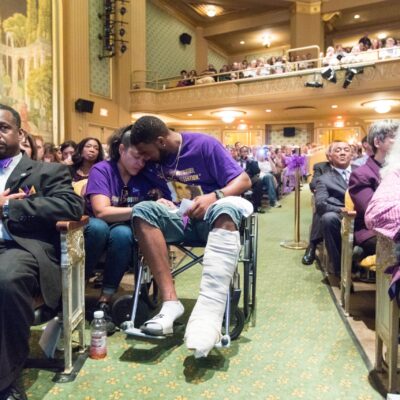|
READ MORE • Click here for more information on pedestrian safety. |
On the outer fringes of Hollymead Town Center, at the corner of Grand Forks Boulevard and Perseco Lane, there is a townhouse for rent. It’s one of four units in a lonely building, stranded among the raw sites of its as-yet-unbuilt siblings. On September 28, I parked my car near the townhouse and set off on a journey that Albemarle County says it wants lots of people to make. Destination: the Harris Teeter down the hill on Connor Drive. Transportation mode: walking.
|
ON FOOT IN HOLLYMEAD TOWN CENTER
Sidewalks built piecemeal as buildings go up. |
According to the Neighborhood Model of Albemarle County, it is an important goal that residents—especially those who live in the designated growth areas, which include Hollymead Town Center—can get around by walking at least some of the time. Were I to move into this particular townhouse, I’d be buying into a vision of mixed-use, high-density development where people’s homes are close to the places where they work and/or buy groceries, and their journeys among all three can be accomplished without cars. This lifestyle is meant to benefit the environment, traffic congestion, neighborliness, and health—just to name a few.
Hollymead is one of the major developments approved by the county since the adoption of the model in 2001, and I wanted to see how it stacks up to the ideal so far. From the front door of the townhouse, which is part of the Laurel Park development, I headed for Timberwood Boulevard and turned left.
The view was less than pleasing—a drainage pond, construction zones and small scraggly trees—but I did have a sidewalk to travel. That is, I had one until I reached the end of the block of townhouses, where the sidewalk abruptly ended.
Playing catch-up
It’s not only county officials who support the Neighborhood Model. In a 2006 survey of Albemarle residents, 75.1 percent said they favored attempts to concentrate growth in areas designated for urbanization. And 73.4 percent of residents said it was very important for the county to “ensure safety for walkers and bicyclists.” But Vince Caristo, executive director of the Alliance for Community Choice in Transportation (ACCT), says it’s hard to get numbers on how many locals actually travel by bike or by foot. “Overall in the [U.S.], 94 percent of all trips are made by car,” he says.
|
ON FOOT IN HOLLYMEAD TOWN CENTER
Where walking really happens: between shops and parking. |
I stepped onto the edge of the wide street and two vehicles swept past quickly. Where the sidewalk reappeared a half-block ahead, red clay and water had covered it during recent rains, making its first 25 or 30 feet unusable. And then it ended again at the intersection with Laurel Park Road. The Neighborhood Model may list “pedestrian orientation” at the very top of its 12 Principles for Development, but it’s in the county’s subdivision and zoning regulations where the rubber—so to speak—meets the road. And those ordinances are not yet entirely updated to reflect the Neighborhood Model. Amending them is an ongoing process.
“Right now we can’t require sidewalks on all streets in the development areas,” says Elaine Echols, a principal planner with the county. “We oftentimes get a proffer from the developer that says that they will do it. Until we get our zoning regulations changed to make it a requirement,” she says—a project she and her staff are working on right now—walker-friendly development is not as ironclad a guideline as the Neighborhood Model would suggest.
Pedestrian disorientation
After the sidewalk ended again, I continued on—walking in the gutter, across the street from empty office condos. The feeling of the half-built “neighborhood” here is ironically reminiscent of America’s foreclosure-ridden neighborhoods that have gotten so much recent press: lonely, with little human presence and a lot of unoccupied buildings.
|
ON FOOT IN HOLLYMEAD TOWN CENTER
A stairway to nowhere behind Vinny’s and Sakura. |
Caristo says that mixed-use planning and good pedestrian infrastructure are the two most important factors that get people walking, but also crucial is a sense that the walking route is pleasant. “Aesthetics are really important to getting people to actually change their habits,” he says. But the surroundings along Timberwood Boulevard are somewhat bleak: forgettable architecture and lumpy lots of gravel and grass.
Continuing onward, passed by a car every 15 seconds or so, I walked on a few more stop-and-start sidewalks before arriving at a traffic circle. Here, oddly, there were no sidewalks except on the island in the middle of the roundabout—which might be a fine place to walk, except that it’s connected to nothing. And to get to it, I had to dart across the circle, dodging cars that popped suddenly from behind the ornamental grasses planted in the center.
From here I could see the roofs of Hollymead’s retail stores, including Harris Teeter—and I could see that I’d be trekking cross-country to get there. Between me and my destination was a big swath of sloping ground and a barricaded road (Meeting Street, not yet in use). I walked down the hill through short grass—fine for me but not for anyone in a wheelchair or pushing a stroller. I turned right on Connor Drive, still walking in the road, which was lined by plastic erosion fencing, until finally a sidewalk appeared.
Aside from a young tree planted so close to the sidewalk that it pushed me briefly into the street again, I had smooth sailing from here. Walking past Bonefish Grill toward Five Guys seemed perfectly safe, though I noticed that none of the signage on the shops was directed toward me as a pedestrian: It all faced out to the parking lots, meant to be read from inside cars.
If you build it, will they walk?
I hadn’t passed a single walker on my trip, which seems indicative of Hollymead generally. C-VILLE’s Lucy Kim asked employees of various retail businesses in Hollymead whether they or anybody they knew walked to work, and got a collective, resounding “no.”
|
ON FOOT IN HOLLYMEAD TOWN CENTER
Sidewalk in the center of a roundabout, but not around the outside. |
Ruth Grainger, who asked that we not reveal the store where she works, said “I live just over in Forest Lakes and I’m afraid to walk across the street [29N]. I moved here to be closer…but there are no good pedestrian crossings on the way here.” Indeed, other workers said that a lack of completed housing in Hollymead means that Forest Lakes is the nearest option for employees who’d like to live close to work, but echoed Grainger’s wariness about crossing 29N. Others said they live elsewhere in Albemarle, or other counties altogether.
Still, walking is part of Hollymead’s image. “Dining and shopping are within walking distance,” boasts the Southern Development website in its description of Laurel Park, for which it’s the builder. Indeed, says Charlie Armstrong, the company VP of land development, prospective buyers of the townhomes (which start at just under $250,000) are saying that walkability is one benefit that draws them to the development. “Customers are very excited about being able to walk to retail and amenities, being able to walk to Harris Teeter to pick up dinner and buy a gallon of milk,” he says.
Those expectations may not be met for some time. Echols explains, “There are two schools of thought about when you provide sidewalks. One is that you get it with the road. The other school of thought is you get it when the property adjacent to the street develops.” It might seem obvious that sidewalks—like the roads they adjoin—should be a connected network allowing people to travel throughout a development, and should therefore be built when the roads are built. But developers don’t see it that way, mostly because a sidewalk installed early in the building process would likely have to be torn up and rebuilt as buildings are erected.
“Often the builders install them as one of the last steps in construction because there’s a lot of landscaping and grading and heavier construction that needs to go on before the surface finishing [including sidewalks],” Armstrong says.
In Hollymead, says Echols, “There is a commitment to provide sidewalks in all streets in the development.” But the sidewalks are part of individual site plans, so they will be built piecemeal in front of each building as it goes up. “As it fills up, it ties in together,” says Gerald Gatobu, a county planner. “Once the buildout is achieved it’ll look much better.”
|
ON FOOT IN HOLLYMEAD TOWN CENTER
A muddy finale. |
Echols agrees that Hollymead will take time to achieve its promise. “I don’t believe that it’s time that [sidewalks] should be in,” says Echols. With various developers involved in building everything from homes to hotels along Timberwood’s many sites, and an economy that’s slowed down construction across the board, it’s hard to estimate when Hollymead’s sidewalk network will finally be complete.
Delayed sidewalk construction can have strange consequences. In one case that came before the county Planning Commission in January 2008, residents actually opposed having sidewalks installed in their neighborhood. Mosby Mountain is off Old Lynchburg Road and straddles a boundary between growth and rural areas. Developer Gaylon Beights had built the subdivision in 2005 and 2006 without the sidewalks he’d promised in plans; by the time he got around to putting them in, residents had gotten used to their mailboxes and landscaping and didn’t care for the disruption.
After Mosby residents told the Planning Commission that sidewalks were unnecessary and even ugly (they were to be made of asphalt rather than concrete), commissioners voted to waive the sidewalk requirement in most of the development, but stood firm on having sidewalks along two cul-de-sacs that fall in the growth area. If that scenario is unlikely to play out at Hollymead—which is entirely in the growth area—the timing aspect feels familiar. Beights’ lawyer, Valerie Long, told commissioners that the reason he’d not installed sidewalks earlier (i.e., at the same time he built Mosby’s roads) was to avoid having to tear them up during construction.
Walkers, unite
I did my shopping, emerged with one bag of groceries, and started the journey back. Between Vinny’s and Sakura, I noticed something odd: a stairway to nowhere that mounted a tall bank and then ended. (C-VILLE reported on this poorly planned egress in 2007.) Curious, I climbed its steep, uneven steps and then followed an ad hoc footpath that forded a deep ditch and continued up the hill through the grass. It crossed unused Meeting Street and continued through an empty lot toward more townhouses.
I felt strangely buoyed by this path. It proved that people do walk around here, and that they’ll find their own way even if the infrastructure doesn’t exist. Of course, with the ongoing development of Hollymead, the path is likely a temporary one. (More construction will eventually line both sides of Meeting Street.)
One might argue that it’s unfair to judge the pedestrian infrastructure in a development that isn’t even finished. But Hollymead has been under construction since 2003, and the Neighborhood Model is now more than eight years old. Were I, say, a parent of young kids who’d signed onto the walkability dream three or four years ago, I might be justified in losing my patience.
“If our county enacted everything that we planned to do, it would be a pretty amazing place,” says Caristo. “They have to do a lot of work making sure they follow through with their plans.”—Additional reporting by Lucy Kim










